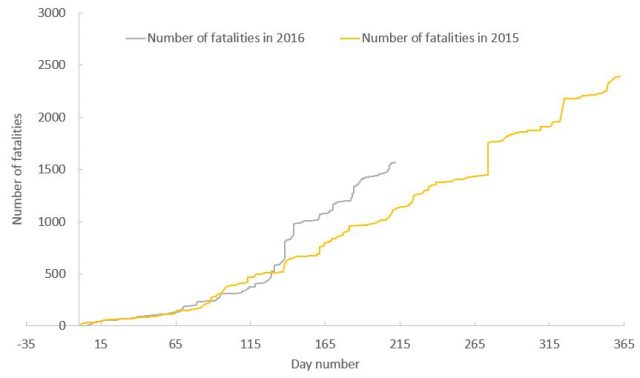1 August 2016
2016 landslide losses
Posted by Dave Petley
2016 landslide losses
We are now in the peak season for landslides globally as both the Asian monsoon and the typhoon season reach full power. I posted late last week about the impacts of the monsoon in South Asia, especially in Nepal. To date the typhoon season in the West Pacific has not been particularly powerful, but in the next 24 hours a major storm (Tropical Cyclone Nida) will make landfall in South China. The current track suggests that it will be a direct hit on Hong Kong, which could be interesting. Fortunately this is not a very powerful storm, and it is reasonably fast moving:

Hong Kong Observatory track forecast for Typhoon Nida
.
Nonetheless this has the potential to generate reasonable amounts of rainfall, so there may be a real landslide risk. The Hong Kong Observatory rainfall maps will be worth following for the next two days or so.
I thought this would be a good time to reflect on 2016 landslide losses to date, and to compare those with 2015. The graph below shows the number of fatality-inducing landslide that I have recorded in 2016 compared with the full year distribution for 2015. Remember that we had thought that 2015 would might a bad year due to the El Nino conditions. This did not turn out to be the case – indeed losses were surprisingly low:

2016 landslide losses: The number of fatality inducing landslides in 2015 and 2016
.
The difference between the two years is stark. The effects of the very weak landfalling typhoon and Asian monsoons in 2015 meant that losses were comparatively low. The strong Asian monsoon this year is resulting in far higher numbers of loss inducing events.
The effect is also clear in terms of the number of fatalities. This data is always far less clear as a single landslide with very high levels of loss can dominate. But nonetheless 2016 landslide losses are far higher than those in 2015 at the same point:

2016 landslide losses: a comparison of landslide fatalities in 2015 and 2016
.
Typically large numbers of losses occur in the period August to October, especially in China. If the current trend continues then 2016 could turn out to be a bad year, although a great deal will depend upon the remainder of the typhoon season.


 Dave Petley is the Vice-Chancellor of the University of Hull in the United Kingdom. His blog provides commentary and analysis of landslide events occurring worldwide, including the landslides themselves, latest research, and conferences and meetings.
Dave Petley is the Vice-Chancellor of the University of Hull in the United Kingdom. His blog provides commentary and analysis of landslide events occurring worldwide, including the landslides themselves, latest research, and conferences and meetings.